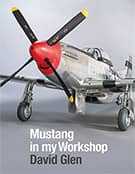Pneumatics 2: some ancillaries
Tuesday, 22nd July, 2014
The arrangement of the pneumatic system varies in the Mk IX, dependent not least on the location of the air tanks. While relatively complex, much of it is hidden from view so can be ignored in a model. However, for my version I needed to include in the space behind frame 11 a significant cluster of pneumatic fittings and associated air-lines and T-unions, including the cup-shaped air filter and cube-like pressure maintaining valve, both of which are visible in the belly beneath the compressed air bottles. From my limited references, the arrangement of the remaining ancillaries is less clear. The partly visible magnetic and pressure reducing valves are bolted to a flanged mounting plate strapped to the back of frame 11. I took great pains to scale the plate from photographs, only to discover afterwards that I had a GA drawing showing not only the piece itself, but its full complement of kit. This is not the first time that this has happened, and it serves to illustrate the futility of accumulating reference material if it is not sorted and managed efficiently!
Further forward, the big cylindrical flap operating ram is located on the port side close to the fuselage floor between frames nine and 10. Being just visible with the pilot’s seat in position, I included it – albeit as an afterthought – although I omitted its two flexible air hoses and their respective pressure inlets since these are arrayed on the inboard side and totally hidden beneath the seat. The ram casing was simple to turn in the lathe but the assembly was difficult to install, not least because the elevator control cables are in the way. At the forward end the stainless steel ram locates into the fork-end of a lever on the flap actuating shaft (installed last year). The other end bolts via a universal coupling to a heavy-duty bracket on the bottom of frame 10, and this is where the difficulty lay. I got there in the end, but not without a full day’s work, which included some significant ‘fudging’ and self-recrimination over the need to do things in a more considered sequence.







